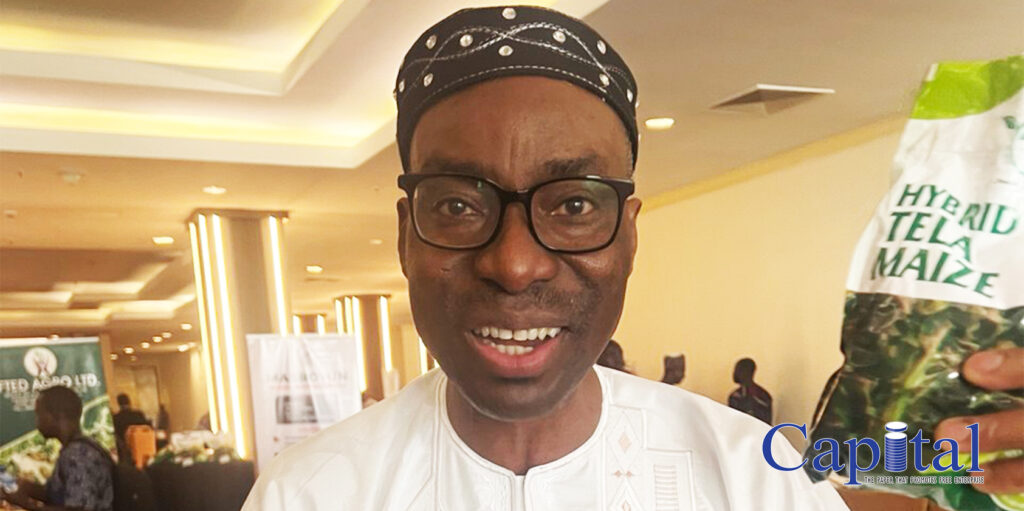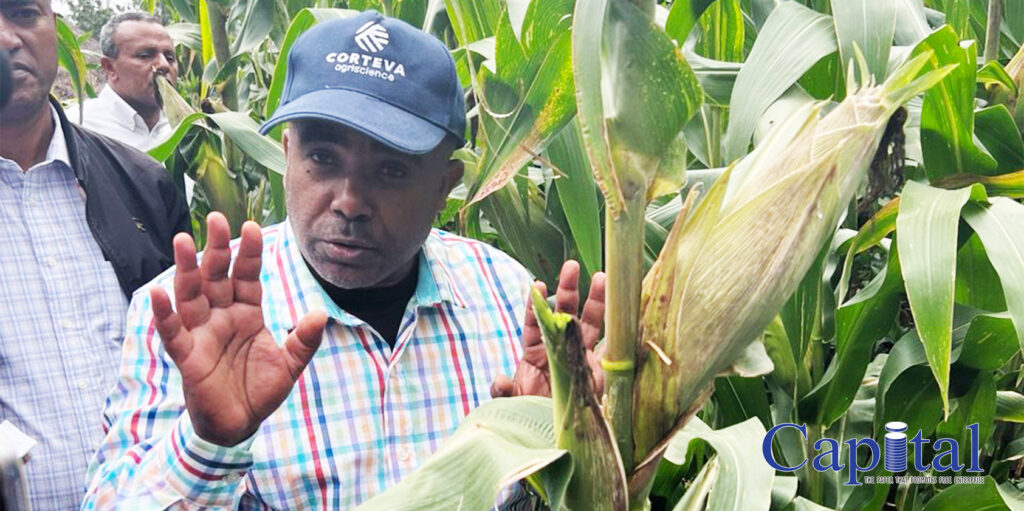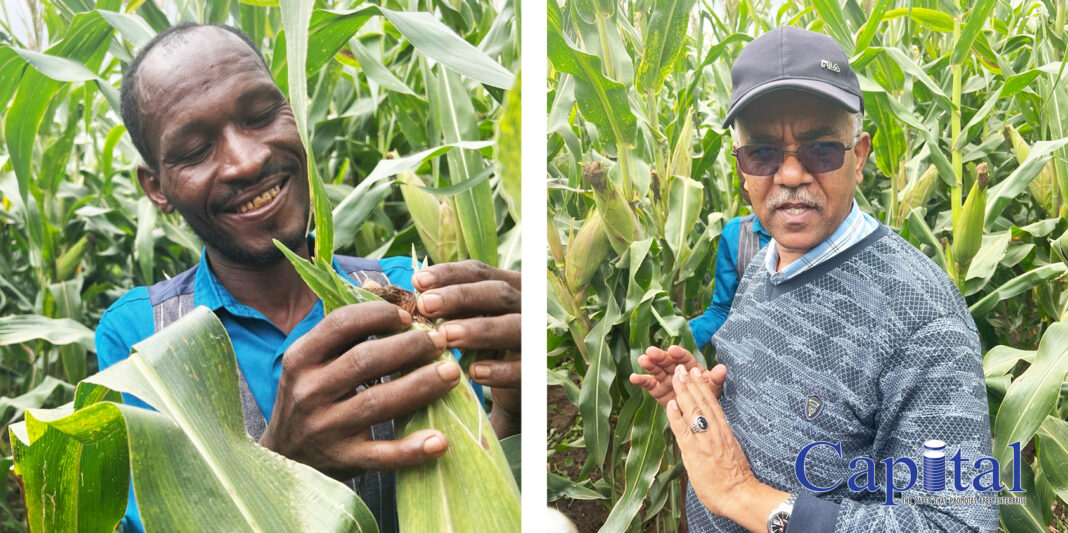By Muluken Yewondwossen
A testimony from Semon Mengesha, a theology graduate and church leader near Hawassa, highlights a growing trend among local farmers. After two successful years cultivating a high-yield maize variety, he notes a strong desire in his community to adopt the same seeds.
This trend is supported by Dr. Sylvester Oikeh, a senior Nigerian maize scientist, who explains that Ethiopian farmers, having historically lacked access to high-quality seeds, are eager to adopt the proven varieties used by their counterparts in Kenya, especially after witnessing their abundant harvests. This demand pattern has been observed previously across Latin America.
At 35, Semon has emerged as a local advocate for innovative agricultural solutions. For the past two years, his half-hectare farm has been a trial site for a genetically modified (GM) maize variety, and his success has captured the attention of his entire community.
“The farmers in my neighborhood are fascinated by the maize crop in my field,” Semon, who resides in Sama Ejersa kebele, Dore Bafeno woreda—40 km northwest of Hawassa—told Capital. “My congregation begs me for the seed I used, even though they know it was part of a trial.”
His experience reflects a wider global trend. Oikeh, Project Manager for the TELA Maize Project at the African Agricultural Technology Foundation (AATF), mentioned that farmers will inevitably seek the best available technology, often across borders. This is currently occurring in East Africa, similar to a situation in Ethiopia where cotton farmers near Sudan have resorted to using smuggled GM seeds for improved yields.
A Solution to Pressing Challenges
The TELA Maize Project, a partnership between the Ethiopian Institute of Agricultural Research (EIAR) and AATF, developed this GM maize to tackle critical challenges: climate change, the damaging Fall Armyworm (FAW) that appeared in 2017, and stem borers.
Farmers like Semon have been in urgent need of a solution. Although they traditionally cultivated accepted hybrid varieties, their harvests were frequently devastated by pests. Pesticides are not only prohibitively expensive but also largely ineffective.

“The chemicals are unaffordable, and we worry about contaminating the crop,” Semon explained. Scientists corroborate these concerns, highlighting that pesticides pose health and environmental risks. “We don’t buy it, so our yield suffers. Even when we do, the pesticide isn’t fully effective,” he added. Farmers also report the market is flooded with adulterated and counterfeit chemical products.
The core issue extends beyond affordability to serious concerns about harmful side effects. Professor Firew Mekibib, Chair of the National Variety Release Committee (NVRC), has identified maize, beans, and sweet potatoes as strategic crops for the Sidama region. During a recent field visit, he emphasized the need to protect farmers and their land from the negative impacts of chemical inputs.
The TELA project estimates that safeguarding a maize farm requires at least three rounds of chemical spraying, costing around USD 750 per hectare—an unattainable sum for most smallholder farmers, not accounting for labor and other expenses.
A Transformative Harvest
For Semon, the TELA maize variety has been life-changing. Engineered for insect resistance and drought tolerance, this crop requires no chemical sprays.
“I am thrilled to be one of the few selected for the field trial. Since I started cultivating this new GM seed, which protects against stem borers and fall armyworms, my harvest has completely transformed,” he shared. Previously, he was left with only a small surplus for market after feeding his family. His latest trial harvest yielded 13 quintals for sale, which commanded a higher price due to the crop’s superior quality.
Semon also noted benefits for integrated agriculture: “I also get animal feed from this maize since it has good, long-lasting green leaves.” Professor Firew emphasized that this is another significant advantage.
Leta Tulu (PhD), a senior scientist, explained the importance of the leaf in a maize plant: “This new variety keeps the leaf green, eliminates the need for chemical sprays, and saves substantial costs in time and money.” He clarified that while most Ethiopian maize growers already use hybrid seeds, this variety stands out due to its built-in protection against insects and drought. “Otherwise, the seed system remains the same conventional one that farmers have used for decades.”
Approval granted, but distribution delayed
There is renewed hope for Semon’s community and other farmers, as new high-performing varieties have been approved for commercial sale.
In a historic decision, Ethiopia’s NVRC approved three TELA maize varieties for commercial release in March: one that is insect-protected and two that are both insect-protected and drought-tolerant.
“We had planned to demonstrate the technology on 120 farmers’ plots this season, but were delayed by various issues,” Leta stated. He added that local seed companies will soon multiply and supply the seeds at an affordable rate.
Despite this decision, which is expected to significantly boost production of a key national staple, experts warn of frustrating delays. Firew explained that these improved versions of hybrid maize have been used by Ethiopian farmers for decades. “This is the same hybrid maize, only modified for protection against insects and drought,” he said, expressing confidence that they will revolutionize production within a few years.

However, a significant gap exists between approval and availability. Tesfaye Disasa (PhD), the TELA Project Country Coordinator, expressed frustration over unforeseen obstacles from authorities following a lengthy approval process. He cited restrictive conditions imposed by the Environmental Protection Authority (EPA)—such as specific growing zones and reproductive isolation requirements—as the main barrier.
Experts argue these conditions are impractical, infringe on farmers’ rights, and fall outside the EPA’s mandate once environmental release is approved. They contend that seed multiplication and distribution should be overseen by the Ministry of Agriculture.
“Every new technology requires testing, but we are often slow to adopt them,” Tesfaye told Capital. “This farming season, we planned extensive demonstrations. Unfortunately, this was impossible due to very limited seed multiplication.”
Firew defended Ethiopia’s rigorous system, noting that it has one of the strongest variety release systems in Africa. “We have released 1,600 different seed varieties based on field trials proving their suitability for Ethiopian conditions,” he said. He emphasized that the final approving authority must be discerning, retaining the discretion to reject varieties even after endorsement by scientific bodies. Ethiopia approved three of the four TELA varieties, while Nigeria and Kenya approved all four.
“The EPA had also approved all four, but we dropped one,” Firew explained.
A warning from history
Oikeh warns that delays can create significant problems, citing a precedent from Latin America. “When Brazil banned GM crops and Argentina embraced them, Brazilian farmers simply bought seeds from Argentina. A study found that 75% were doing this, forcing the government to legalize GM crops,” he explained. The concern is that Ethiopian farmers may resort to similar informal channels if access to seeds is further delayed.
Experts caution that unless the EPA’s conditions are amended, adequate seed supplies may be postponed for another year. Currently, the EIAR is conducting limited demonstration plots instead of full-scale seed multiplication.
Despite these challenges, there is hope. These new varieties offer potential yield advantages of up to 60%, improved grain quality, and significantly lower production costs while also reducing environmental and health risks.
As Firew stated, “The remaining key issues are demonstration, popularization, and supply. Farmers are now asking for the seed.” The pressing question remains: how long will they have to wait?
He recalled that Ethiopia once depended on hybrid seeds from Kenya and Zimbabwe but has now become self-sufficient, ranking second only to South Africa in maize productivity on the continent.
“In 2016, South Africa released five varieties of the Tela product for its farmers. Currently, smallholder farmers in the Mpumalanga and Limpopo provinces are benefiting from it,” Oikeh noted in an interview a year ago. The ultimate endorsement of these new varieties, Firew concluded, must come from the farmers themselves.







